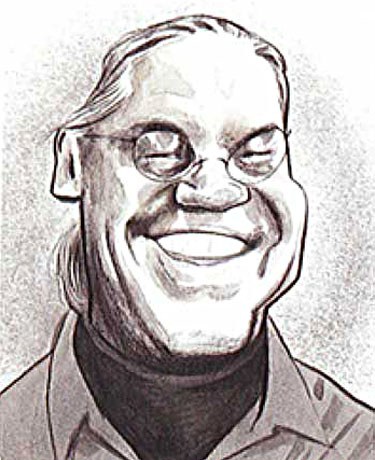
I didn’t know Patrick when he lived in New York in the ’70s. At that time he was a cog in the New York Times machine. A mid-western boy, he returned, answering the call of The Progressive, to raise his family and do good work in Madison, Wisconsin. This was an event, it turned out, that was decreed in graphics heaven.
This was at the start of the Reagan years, a time of corporate media straightjacketing and a very sophisticated White House propaganda operation. In the media as a whole, there was a fairly tight lock-down on criticism of the new president. Under the brilliance of editor Erwin knoll and Patrick, The Progressive was about the only place where the straight story in words and pictures was able to flourish.
Patrick’s approach to working with artists was revolutionary — it was hands off the art. He felt that as long as the right artists was chosen for a project there would be no need for interference. He knew that this would bring forth in artists great honesty, inspiration, and craft.
The work that poured into the magazine was by some of the strongest and smartest artists of its time: Brad Holland, Marshall Arisman, Francis Jetter, Sue Coe, Joe Ciardiello, Randall Enos, Ralph Steadman, among may others. It all amounted to something a great deal more than good art in a magazine. It was a moment in publishing, not unlike periods of lucky convergences that produced such magazines as Puck, The Masses, Simplisissimus. It was a statement about the power publications could gather with just a bit of courage and clarity. I remember calendars of art and a special art project on the nuclear freeze movement.
The first journalism I ever did, an essay on the fading family farm, was done for Patrick. Not ever being a hot mag, The Progressive was praised by those who knew the value of art in journalism. Predictably, there were some who never really got what was going on. Finally, such a person became editor after Erwin’s untimely death.
After numerous battles about content in art, Patrick lost his job over a Brad Holland piece. But before leaving, Patrick made sure the piece did run.
Patrick, who still designs in Madison, works with artists with whom he’s formed life-long friendships. A very humble guy, he is a very great influence in our industry. Here’s to him, and the hopes that the Richard Gangel Award will be a reminder now and forever of the contribution he’s made and how we all feel about him.
Text and portrait by Steve Brodner
